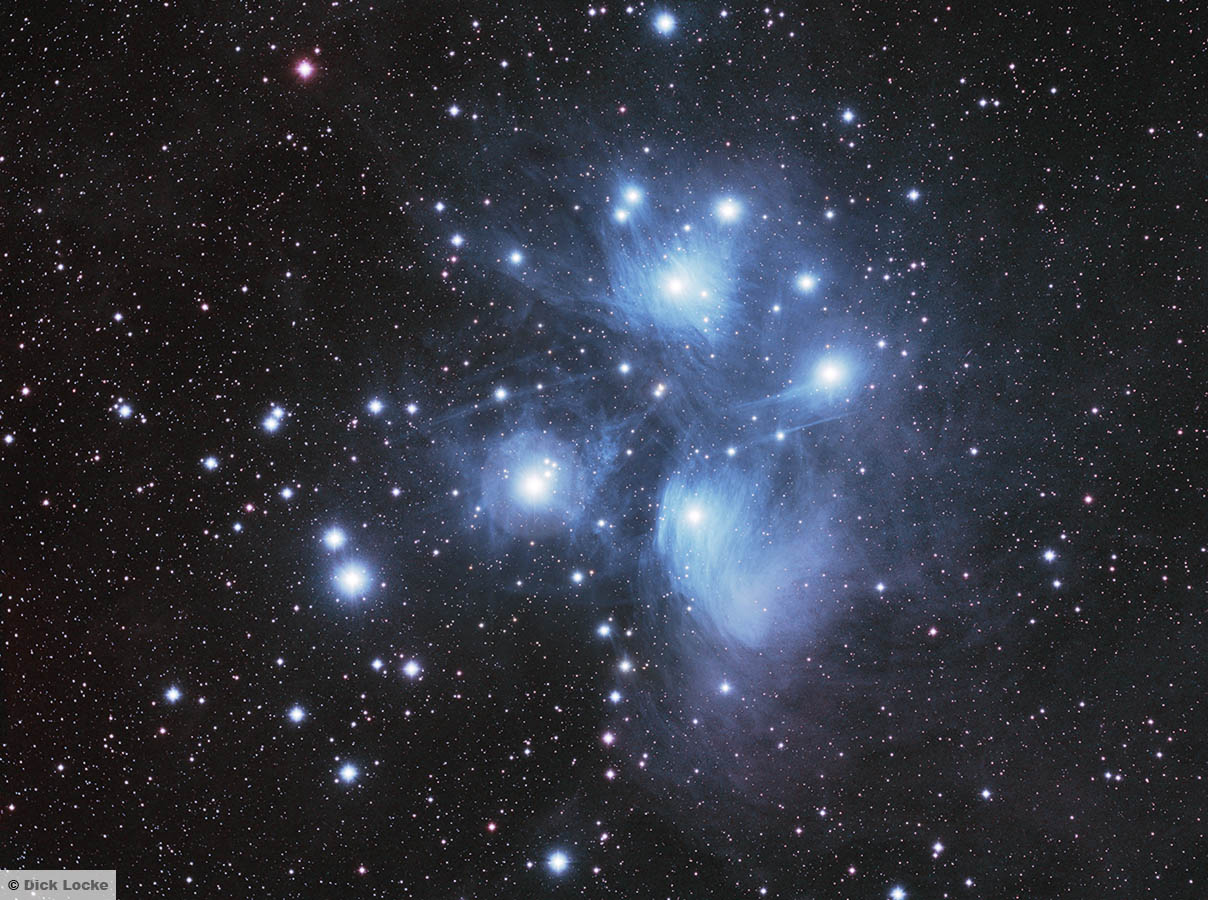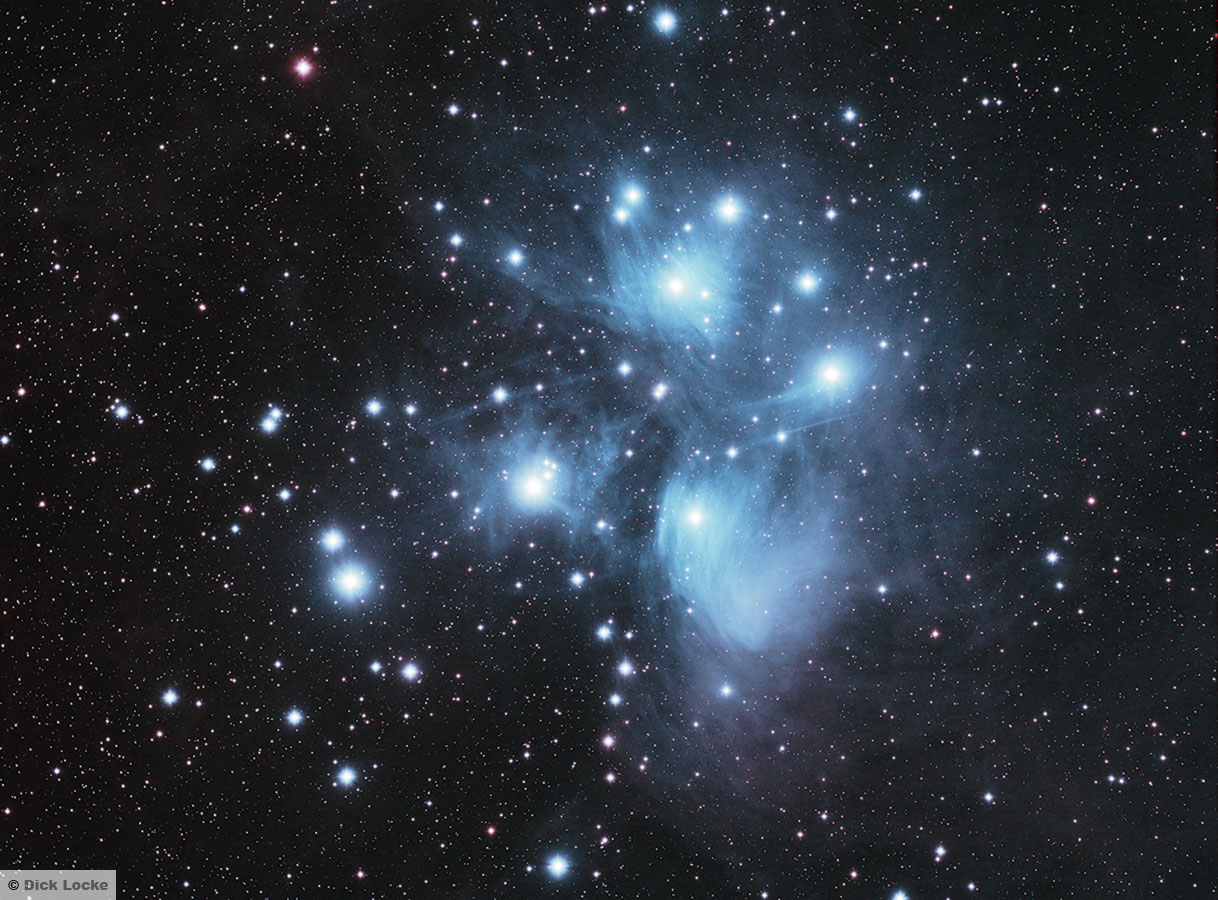
The Seven Sisters (M45) - 7 Hour 2013 Crop

"The Pleiades" is Messier object 45, IC 353, and is also known as "The Seven Sisters." It is an open star cluster and features a nice blue reflection nebula. As it resembles a small dipper, it is often mistaken for the Little Dipper. (The real Little Dipper is much larger and always directly North.) Generally there are only 6 stars clearly visible in this object, and there's been discussion as to why there are seven sisters instead of six. This object is quite high in the sky and well-placed for viewing in the Fall. More info about The Pleiades is at SEDS. Quoting SEDS: Their Japanese name is "Subaru", which was taken to christen the car of same name. The Persian name is "Soraya", after which the former Iranian empress was named. Old European (e.g., English and German) names indicate they were once compared to a "Hen with Chicks".
Imaging Discussion for Astrophotographers: This image combines 86 total exposures from the 2012 Davis Mountains trip. I used the "color" images from my Takahashi TOA 130 as a base, then blended in Takahashi FSQ-85 filtered and combined frames after aligning everything. The large halos around the bright stars are from the QHY8 shots, and I used the 8300 shots to dim those somewhat. If I blended to completely remove the halos too much noise came through, so I tried to strike a balance.
Image Details: This image is comprised of the 42 exposures from the QHY8 interim version (see discussion below), plus 44 * 5 minute frames compose of 17 Red, 9 Green, and 18 Blue frames from the 2012 Davis Mountains trip, using the SBIG ST-8300m (monochrome) CCD camera with the FW8-8300 filter wheel, Astrodon 36mm RGB filters, and the Takahashi FSQ-85 telescope (no reducer), and AP 900GTO mount. The whole mess was aligned and in Registar, and combined and enhanced using Photoshop CS6. Various enhancements using Noel Carboni's actions & Neat Image noise filter.

Image (above) details: This image uses the wider FSQ-85 image as a base, with the narrower TOA-130 image blended into the center area to enhance detail and reduce noise.

Image details above; this 44 * 5 minute frames from the FSQ-85 telescope and SBIG 8300M camera from the 2012 Davis Mountains trip. It shows a wider view of this dusty area, without additional blending into the central area.

Imaging Discussion for Astronomers: The "Interim" version above represents about 3.5 hours of total exposure. The image is a combination of two stacks of 23 + 19 (each 5 min) images of different orientations. You can see some areas are noisier than others; those areas are where the images don't overlap. I also have a number of frames from my monochrome camera that I'll be working to combine into a "master" image so watch this space. Compared with the image below, this one goes quite a bit deeper with the 3.5 hour (vs 1.3 hour) total exposure. However, I was shooting at f7.7 with the flattener above, vs. f5.8 with the reducer below. The flattener provided nice quality stars across the frame, which makes it better for mosaics. I'm pretty sure I'll go back to the reducer next time, however!
Image Details: Blend of 42 exposures of 5 minutes each with the Takahashi TOA 130 (a 5" APO refractor) with flattener, QHY8 CCD Camera from the 2012 Davis Mountains trip, AP 900GTO mount. Aligned and combined in Registar, major tweaks in Photoshop CS6. Star shrinking using Noel Carboni's actions.
Galaxy UGC2838 is visible on the lower right, especially on the larger picture. The Sky has that as a mag 17.88
Image details: 20x4 minute exposures (80minutes total exp) on 2 nights, 1/02/06 and 10/28/05. Takahashi TOA 130 (a 5" APO refractor) and Canon EOS D20a.
Imaging data from this evening1/02/06; The images from this session feature 69 averaged flat frames median combined, along with 16 dark frames averaged. Temperature ranged from ~51 degrees F at the start of imaging to 42 degrees when I was packing up and doing my last darks. My current image processing workflow is here.
Image Info:
8x4 minute exposures = 32 minutes total, ISO800
Canon EOS 20Da (unmodified), Takahashi TOA 130 (a 5" APO refractor), Losmandy G-11 mount.
Images from NHAC Neal dark sky observing site, 10/28/2005, ambient temp about 48 degrees,
SBIG STV autoguider using Celestron ST-80 guidescope
Combined in Registar, No darks, lights, or flats; moderate crop of original,
Processed in Photoshop, saved as 1200 pixels wide

This is a driveway shot from about 7:15 p.m., just as Alcyone slid past the terminator and the Moon slid past some pine tree branches! It's a tiny blip at the bottom. This is a 6 second exposure at ISO 100. Local sunset was at 6:40 p.m., making this shot 35 minutes after sunset. Takahashi TOA 130 (a 5" APO refractor) and Canon EOS D20a.
-m45-meteor_small.jpg)
Meteor through M45! This is a single 4 minute exposure from the series above...
Old M45 Page | Featured Astronomy Photos |
My Messier Page | Images Home |
Astrophoto Home | Takahashi TOA 130 |
Copyright © Dick Locke. All Rights Reserved.
Contact and Image Use Information